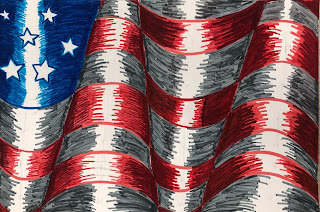Middle School Version
Kalie'f finished
Kali, No Name,
Mary, Kiera
Mary, Kiera
Intro to Art Class 2021
Emma, Estrella &’Ariel
Intro to Art Class 2021
Kaleece, Chevelle,
Breanna, Josilen,
Kaylynn & Desiree
Breanna, Josilen,
Kaylynn & Desiree
2019
2019
Mariana, Carie, Krissie, Preciosa,
Francie, Braylon,
Yuka & Jason.
HOW TO BEGIN the FLAG
Draw a W on the paper, but the tips should be cut off.
Use curved lines (no more than 13) going down the even numbered columns.
Try to make the same amount.
Make curved lines in the opposite direction on the odd numbered columns.
They should join another line from the previous column.
In the top left corner, create starts that curve with the line.
you can use that line as a guide line for the arms of the stars.
When coloring down the columns, use value,
The center of the column should be the lightest spot, like a shiny glare.
You should increase pressure as you get closer to the edge of the line.
I made a guide line down the center to keep me from coloring there.
I will erase it later.
you can see the elementary school version here...
POP ART
Artist that use American Flags as their subjects are considered
POP artist.
Here are 2 of them.
Jasper Johns
(above)
Using Repetition and Complementary Colors
Keith Haring
We will be using CONTOUR LINES to make our flag appear as 3D.
It will be an optical illusion.
Finished Examples coming soon...
We are working on it.
Students working on creating VALUE on each column of their furling flag.
Grades 6-8
Students were instructed to make 5 columns using slightly diagonal but mostly vertical lines.
They then made bending lines (frowns and smiles) opposing on each column for the
CONTOUR LINES.
They added stars in the upper left corner that also are suppose to go on a curve and be staggered.
For color, we used red, grey and blue to do the shading in each column.
They were allowed to use colored pencil, crayons or marker for the shading.
They previously learned special shading techniques in order to do the challenge of marker
(Stippling, Hatching, Cross Hatching and scribbling).
Mrs. Morgan's marker above
Bella and Zack's American Flags
(below)
Practice your value before you begin.
(below)
Practice your value before you begin.
Teachers can
Fall 2019
MMS Students
Advanced Alternative
Use the complementary color idea from Jasper Johns as inspiration for a new colored flag.


































































